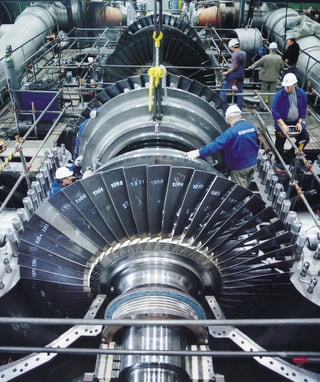This post is one in a series featuring the complete slate of advanced energy technologies outlined in the report This Is Advanced Energy.

Gas turbine technology is mature and widely used, with innovations driving new improvements in efficiency, performance, and cost. In its most basic configuration, the simple cycle gas turbine (SCGT), air is compressed and mixed with fuel (usually natural gas), then the mixture is burned in a combustor. The resulting hot, pressurized gases expand through the turbine section that drives the compressor and an electric generator. In a combined cycle gas turbine (CCGT) plant, also called a natural gas combined cycle (NGCC) plant, the hot exhaust gases leaving the turbine pass through a heat recovery steam generator, producing steam that is used to generate more electricity with no additional fuel. This process can increase efficiency to 60%, compared to about 40% for SCGTs. Most gas turbine plants in operation use so-called “heavy duty” or “industrial” turbines, with units ranging from about 1 MW to over 300 MW. The other main type of machine, an aeroderivative gas turbine, ranges in size up to about 90 MW. These turbines are more lightweight, compact, and even more efficient. Another class of machines, microturbines, have lower efficiencies than the larger turbines, but are well suited for onsite power and CHP due to their compact footprint and smaller size (25 kW to 500 kW).
In 2013, there were 1,725 natural gas-fired plants operating across the United States, such as the 785 MW CCGT Towantic Energy Center in Oxford, Connecticut owned and operated by Competitive Power Ventures. The availability of low-priced natural gas (much of it produced domestically) has increased the utilization rates of existing SCGT and CCGT capacity while also driving investment in new units, such as Invenergy’s 584 MW CCGT plant in Rock Falls, Illinois, completed in 2015. As a result, the share of electricity generated from natural gas has increased rapidly in the United States, up to 32% in 2015 (through Q3) compared to 18% in 2004. This electricity is generated by ever-more efficient plants, with GE’s recently released H class combined-cycle turbines achieving over 61% net electrical efficiency.
Natural gas-fired generation is an important contributor to electric reliability, with turbine technologies exceling in a range of applications. Rapid startup and ramping capabilities make SCGTs ideal for meeting peak demand and integrating variable renewable generation. Highly efficient CCGTs are primarily used to provide intermediate and baseload power. As the needs of the grid evolve, new gas turbine models are being deployed. For example, the intercooled aeroderivative is well suited to variable renewable integration due to its at efficiency profile over a wide load range. Smaller industrial turbines, aeroderivative turbines, and microturbines also give commercial and industrial energy consumers additional onsite energy choices. Coupled with inexpensive natural gas, CCGTs in particular are cost-effective new-build options. The levelized cost for CCGTs is estimated at $61- $87/MWh, while that of gas peaking plants is estimated at $179-$230/MWh. For comparison, the levelized cost of coal generation is approximately $66-$151/MWh. With such favorable economics, natural gas accounted for 49% of new generating capacity in 2014, and 55% in the first three quarters of 2015.
Learn more about natural gas, and other forms of electricity generation, transmission, and distribution, in our free report. It's available at the link below!
